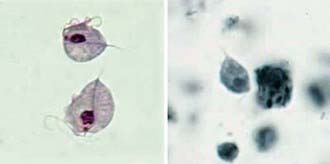Chapter 276 Trichomoniasis (Trichomonas vaginalis)
Trichomoniasis, caused by the protozoan parasite Trichomonas vaginalis, is the most common nonviral sexually transmitted disease worldwide. It primarily causes vulvovaginitis in women but has been implicated in pelvic inflammatory disease, adverse outcomes in pregnancy, chronic prostatitis, and an increased risk of transmission of HIV.
Epidemiology
Over 170 million new cases of trichomoniasis occur yearly, the majority in resource-limited settings. Prevalence and incidence rates are likely underestimated, as most men and up to 30% of women are asymptomatic. Diagnostic accuracy using wet mount microscopy, the mainstay of diagnosis, is less sensitive than previously assumed. While the disease is easily treated, sequelae of untreated infection remain a significant cause of morbidity due to high reinfection rates from untreated partners, underrecognition of asymptomatic cases, and insensitive diagnostics.
From 5 to 8 million cases of trichomoniasis occur each year in the USA. A population-based study conducted in 2005 showed a prevalence of 2.8% in women, 1.7% in men, and an overall prevalence of 2.3%. The incidence of trichomoniasis is highest among females with multiple sexual partners and in groups with the highest rates of other sexually transmitted infections. T. vaginalis is recovered from >60% of female partners of infected men and 70% of male sexual partners of infected women. Vaginal trichomoniasis is rare until menarche. Its presence in a younger child should raise the possibility of sexual abuse.
Trichomoniasis may be transmitted to neonates during passage through an infected birth canal. Infection in this setting is usually self-limited, but rare cases of neonatal vaginitis and respiratory infection have been reported.
Pathogenesis
T. vaginalis is an anaerobic, flagellated protozoan parasite. Infected vaginal secretions contain 101 to 105 or more protozoa/mL. T. vaginalis is pear shaped and exhibits characteristic twitching motility in wet mount (Fig. 276-1). Reproduction is by binary fission. It exists only as vegetative cells; cyst forms have not been described. T. vaginalis damages host cells and tissues by a number of mechanisms. Adhesion molecules allow attachment of T. vaginalis to host cells, and hydrolases, proteases, and cytotoxic molecules act to destroy or impair the integrity of host cells. Parasite-specific antibodies and lymphocyte priming occur in response to infection, but durable protective immunity does not occur.

Figure 276-1 Trichomonas vaginalis trophozoites stained with Giemsa (left) and iron hematoxylin (right).
(From the Centers for Disease Control and Prevention: Laboratory identification of parasites of public health concern. Trichomoniasis (website). www.dpd.cdc.gov/dpdx/HTML/ImageLibrary/Trichomoniasis_il.htm. Accessed August 30, 2010.)

Full access? Get Clinical Tree


